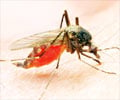The 3D-printed artificial skin developed reveals how mosquitoes transmit deadly diseases and eliminates the need for human and animal testing.

‘DEET and plant-based repellent were found to be useful in repelling the mosquitoes, while mosquitoes fed on the hydrogels without repellent.’





In new research published in Frontiers in Bioengineering and Biotechnology, the hydrogels were found to create a more consistent environment for mosquito testing regardless of species. “It’s a huge game changer,” said Dawn Wesson, associate professor of tropical medicine at Tulane’s School of Public Health and Tropical Medicine. “If we can study how they (mosquitoes) feed, what they do in the process of feeding, we can better understand their potential for transmitting diseases and possibly do things to stop them from feeding.”
More than a nuisance, mosquitoes are perhaps the world’s most dangerous animal. They are vectors for deadly diseases such as malaria, dengue, West Nile virus, Zika and yellow fever. Mosquito-borne diseases are responsible for approximately 725,000 deaths each year, according to the World Health Organization.
New Strategy to Study Mosquitoes' Feeding Behavior
Studying mosquito feeding has long posed a challenge as the use of live mice and humans can be costly and inconsistent. By being able to efficiently produce hydrogels with different blood vessel patterns, Wesson said the ability to study the mechanics of disease transmission and test new types of repellents has increased exponentially. Each testing chamber is outfitted with cameras which record the mosquitoes’ feeding patterns. Artificial intelligence is used to track and sort common bite locations and how long it takes to feed.While mosquito saliva is thought to play a crucial role in disease transmission, questions remain about the process.
“If we can study that process in a more fine-scaled way without having to use animals, we can potentially interrupt transmission, and that would have a very large impact,” Wesson said. “We’re just starting to scratch the surface of what we can do with this product.”
Advertisement
“It provides a consistent and controlled method of observation,” Veiseh said. “The hope is researchers will be able to use that to identify ways to prevent the spread of disease in the future.”
Advertisement















